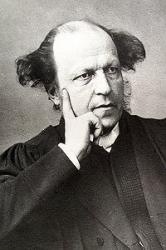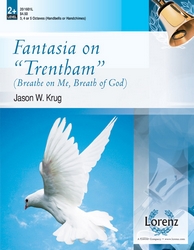- |
User Links
Breathe on me, Breath of God

Breathe on me, breath of God
Author: Edwin Hatch (1878)Tune: TRENTHAM
Prayer Songs
Published in 345 hymnals
Printable scores: PDF, MusicXMLPlayable presentation: Lyrics only, lyrics + musicAudio files: MIDI, Recording
Representative Text
1 Breathe on me, Breath of God,
fill me with life anew,
that I may love the way you love,
and do what you would do.
2 Breathe on me, Breath of God,
until my heart is pure,
until my will is one with yours,
to do and to endure.
3 Breathe on me, Breath of God,
so shall I never die,
but live with you the perfect life
for all eternity.
Psalter Hymnal, 1987
Author: Edwin Hatch
 Hatch, Edwin, D.D., was born at Derby, Sep. 4, 1835, and educated at Pembroke College, Oxford, B.A., in honours, in 1857. After holding important appointments in Canada, he returned to England and became Vice-Principal of St. Mary Hall, Oxford, 1867; and Rector of Purleigh, 1883. (See also Crockford). He died Nov. 10, 1889. His hymn-writing was limited. One, and that a very spirited lyric, is in Allon's Congregational Psalmist Hymnal, 1886 "Breathe on me, Breath of God." (Whitsuntide.) Dr. Hatch's hymns were published in his posthumous Towards Fields of Light, London 1890.
--John Julian, Dictionary of Hymnology, Appendix, Part II (1907)
Go to person page >
Hatch, Edwin, D.D., was born at Derby, Sep. 4, 1835, and educated at Pembroke College, Oxford, B.A., in honours, in 1857. After holding important appointments in Canada, he returned to England and became Vice-Principal of St. Mary Hall, Oxford, 1867; and Rector of Purleigh, 1883. (See also Crockford). He died Nov. 10, 1889. His hymn-writing was limited. One, and that a very spirited lyric, is in Allon's Congregational Psalmist Hymnal, 1886 "Breathe on me, Breath of God." (Whitsuntide.) Dr. Hatch's hymns were published in his posthumous Towards Fields of Light, London 1890.
--John Julian, Dictionary of Hymnology, Appendix, Part II (1907)
Go to person page >Text Information
Related Texts
| First Line: | Breathe on me, breath of God |
| Title: | Breathe on me, Breath of God |
| Author: | Edwin Hatch (1878) |
| Meter: | 6.6.8.6 |
| Place of Origin: | England |
| Language: | English |
| Notes: | French translation: "Souffle du Dieu vivant" by Suzanne Bidgrain, "Souffle sur moi, mon Dieu" by Shirley Judd; German translation: "Weh', Atem Gottes, her" by Hanns Lilje; Spanish translation: See "Da vida a mi alma, oh Dios" by George P. Simmonds |
| Copyright: | Public Domain |
| Liturgical Use: | Prayer Songs |
- (hymns)
- (hymns)
- (hymns)
- (hymns)
- (hymns)
- (hymns)
- (hymns)
- (hymns)
- (hymns)
- (hymns)
- (hymns)
- (hymns)
- (hymns)
- (hymns)
- (hymns)
- (hymns)
- (hymns)
- (hymns)
- (hymns)
- (hymns)
- (hymns)
- (hymns)
- (hymns)
- (hymns)
- (hymns)
- (hymns)
- (hymns)
- (hymns)
- (hymns)
- (hymns)
- (hymns)
- (hymns)
- (hymns)
- (hymns)
- (hymns)
- (hymns)
- (hymns)
- (hymns)
- (hymns)
- (hymns)
- (hymns)
- (hymns)
- (hymns)
- (hymns)
- Year A, Epiphany Season, Fourth Sunday
Related to Matthew 5 (NPM) - Year A, Lent, Fourth Sunday
- Year A, Lent, Fifth Sunday
This is recommended for Year A, Lent, Fifth Sunday by 3 hymnal lectionary indexes including Glory to God: the Presbyterian Hymnal #286 and Lift Up Your Hearts: psalms, hymns, and spiritual songs #747. - Year A, Easter season, Second Sunday
This is recommended for Year A, Easter season, Second Sunday by 3 hymnal lectionary indexes including Glory to God: the Presbyterian Hymnal #286 and Lift Up Your Hearts: psalms, hymns, and spiritual songs #747. - Year A, Easter season, Sixth Sunday
Related to 1 Peter 3 and John 14 (NPM) - Year A, Easter season, Day of Pentecost
This is recommended for Year A, Easter season, Day of Pentecost by 2 hymnal lectionary indexes including Lift Up Your Hearts: psalms, hymns, and spiritual songs #747. - Year A, Ordinary Time, Proper 10 (15)
This is recommended for Year A, Ordinary Time, Proper 10 (15) by 3 hymnal lectionary indexes including Glory to God: the Presbyterian Hymnal #286 and Lift Up Your Hearts: psalms, hymns, and spiritual songs #747. - Year B, Epiphany season, Second Sunday
- Year B, Lent, Fifth Sunday
- Year B, Easter season, Second Sunday
This is recommended for Year B, Easter season, Second Sunday by 2 hymnal lectionary indexes including Glory to God: the Presbyterian Hymnal #286 and Lift Up Your Hearts: psalms, hymns, and spiritual songs #747. - Year B, Easter season, Day of Pentecost
This is recommended for Year B, Easter season, Day of Pentecost by 3 hymnal lectionary indexes including Glory to God: the Presbyterian Hymnal #286 and Lift Up Your Hearts: psalms, hymns, and spiritual songs #747. - Year B, Ordinary Time, Proper 14 (19)
- Year C, Epiphany season, Baptism of the Lord (First Sunday)
This is recommended for Year C, Epiphany season, Baptism of the Lord (First Sunday) by 2 hymnal lectionary indexes including Lift Up Your Hearts: psalms, hymns, and spiritual songs #747. - Year C, Easter season, Easter Vigil
- Year C, Easter season, Second Sunday
This is recommended for Year C, Easter season, Second Sunday by 3 hymnal lectionary indexes including Glory to God: the Presbyterian Hymnal #286 and Lift Up Your Hearts: psalms, hymns, and spiritual songs #747. - Year C, Ordinary Time, Proper 25 (30)
This is recommended for Year C, Ordinary Time, Proper 25 (30) by 2 hymnal lectionary indexes including Lift Up Your Hearts: psalms, hymns, and spiritual songs #747.
English
- A Hundred Songs of God and His Kingdom #d8
- A Manual of Worship: for the chapel of Girard College #23
- A Missionary Hymn Book #5
- A School Service Book #d14
- A Teaching Hymnal: ecumenical and evangelical #130
- A Treasury of Hymns: The best-loved hymns, carols, anthems, children's hymns, and gospel songs #220
- A. M. E. C. Hymnal #18
- African American Heritage Hymnal #317
- African Methodist Episcopal Church Hymnal #192
- Ambassador Hymnal: for Lutheran worship #133 10 shown out of 277
French
German
Spanish
Welsh
Notes
Scripture References:
st. 1 = Ezek. 36:27
st. 1-3 = Joel 2:28, John 20:22
The text is a prayer for renewal by God's Spirit (like Ps. 51:10-12), a renewal that is to be expressed in a life of love (st. 1), in purity of heart and will (st. 2), and in an intimacy with God that heralds the perfection of eternal life (st. 3). In both Hebrew and Greek the Word for "spirit" is the same as "wind/air/breath"; thus in this text the Spirit of God is referred to as "Breath of God."
Intended as a hymn for ordination, this text by Edwin Hatch (b. Derby, England, 1835; d. Oxford, England, 1889) was privately printed in 1878 and then published in Henry Allon's The Congregational Psalmist Hymnal in 1886. Hatch evidently had a simple and childlike faith; that description fits this text as well.
Hatch grew up in a Non-conformist home, was educated at Pembroke College, Oxford, England, and ordained in the Church of England in 1859. A teacher of classics and church history, he taught at Trinity College, Toronto, Canada (1859-1862), and at a high school in Quebec City (1862-1867). In 1867 he returned to Oxford, where he served the academic world with great distinction, particularly as a specialist on early Christian history. His few hymn texts were published posthumously in Towards Fields of Light (1890).
Liturgical Use:
Pentecost; as a prayer for renewal; ordination and other commissioning services; profession of faith.
--Psalter Hymnal Handbook, 1988
Tune
TRENTHAMRobert Jackson (b, Oldham, Lancashire, England, 1842; d. Oldham, 1914) originally, composed TRENTHAM as a setting for Henry W. Baker's "O Perfect Life of Love" (380). Named for a village in Staffordshire, England, close to the town in which Jackson was born, the tune was published with the Baker tex…
For Leaders
Text:
This hymn has been placed in hundreds of hymnals because of its powerful and overwhelming invitation of God’s spirit into the body. The lyrics seem amazingly simple and sensitive for a man who was so intensely educated and driven. The gentle tune swells and falls gracefully, almost like it is breathing itself. This hymn encapsulates a deep desire to be renewed in Christ, and purified by the Holy Spirit. “Breathe on me, Breath of God,” has uplifted the hearts of many a Christian and remains an immortal favorite.
Although Hatch did not produce very many hymns in his lifetime, “Breathe on me, Breath of God” has been published in hundreds of hymnals.
Tune:
The tune most commonly used for this hymn is TRENTHAM, which was originally composed by Robert Jackson in 1888 for Henry Baker’s “O Perfect Life of Love.” Although TRENTHAM has been used with multiple texts throughout the decades, it has been most often placed with “Breathe on me, Breath of God.” Full of hope and power, this tune is the perfect accompaniment for Hatch’s lyrics.
When/Why/How:
Due to the themes incorporated in the text, this hymn will fit in well with the Pentecost season—although it should not be restricted to just one part of the year. It is also especially appropriate for use at confirmations and baptisms.
This hymn should be sung sincerely; slowly enough to allow the words to ruminate but without dragging them out.
Suggested music for this hymn:
For those looking for an instrumental version: “Fantasia on Trentham” is an excellent arrangement for handbells.Luke Getz Hymnary.org
Timeline
Arrangements
Media
Psalter Hymnal (Gray) #420
The United Methodist Hymnal #420
- Audio recording from Ancient and Modern: hymns and songs for refreshing worship #236
- MIDI file from Baptist Hymnal 1991 #241
- Audio recording from Baptist Hymnal 1991 #241
- MIDI file from Baptist Hymnal 1991 #241
- Audio recording from Baptist Hymnal 2008 #334
- MIDI file from Common Praise: A new edition of Hymns Ancient and Modern #174
- MIDI file from The Cyber Hymnal #601
- Audio recording from The Hymnal 1982: according to the use of the Episcopal Church #508
- Audio recording from Glory to God: the Presbyterian Hymnal #286
- MIDI file from Gospel Melodies and Evangelistic Hymns #106
- Audio recording from Lift Up Your Hearts: psalms, hymns, and spiritual songs #747
- Audio recording from Lift Up Your Hearts: psalms, hymns, and spiritual songs #747
- Audio recording from The New English Hymnal #342
- Audio recording from The New English Hymnal #342b
- MIDI file from Northfield Hymnal: for use in evangelistic and church services, conventions, sunday schools, and all prayer and social meetings of the church and home #63
- Audio recording from Psalter Hymnal (Gray) #420
- MIDI file from Psalter Hymnal (Gray) #420
- MIDI file from Psalter Hymnal (Gray) #420
- Audio recording from Small Church Music #38
- Audio recording from Small Church Music #38
- Audio recording from Trinity Hymnal (Rev. ed.) #334
- MIDI file from The United Methodist Hymnal #420
- Audio recording from The United Methodist Hymnal #420
- MIDI file from Worship and Rejoice #461
- MIDI file from Worship in Song: A Friends Hymnal #135


 My Starred Hymns
My Starred Hymns






